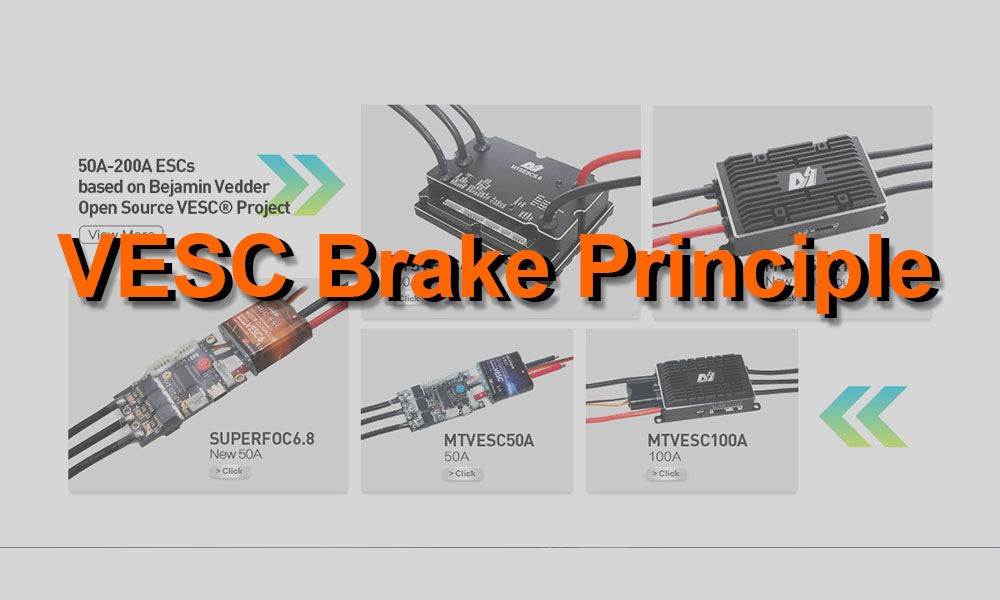1. If a vehicle does not need mechanical brakes, but must be able to brake, it must use electronic brakes. The principle is that the kinetic energy on the motor and the load can be used as a generator through the DC motor to convert the kinetic energy into electrical energy. Then the electric energy is consumed by heating and charging.
2. The electric energy that is emitted must not only charge the battery, but also release the heat. What is the process?
2.1 At this time, VESC has to make a distribution, which current is used to charge the battery, and which current is used for heating.
2.2 When the remote control commands the VESC to brake, the MOS tube does not inject current into the motor under the control of the MCU and the driver IC.
At this time, the motor becomes a generator, and voltage is generated on the motor phase cables. If you connect a load, let this voltage generate current, and then absorb these currents, the motor will decelerate rapidly. If the load is not connected, the motor will coast freely without braking effect.
2.3 Although the MOS is always connected to the motor phase cables, if it is not turned on, the surge voltage on the motor line will be blocked to the outside of the ESC. Unless the voltage is too high to break down the MOS or other devices, the ESC will not be damaged. . However, this has no braking effect!
2.4 In order to realize the greed and desire of human beings, MOS took the initiative to open up to meet their own challenges. At this time, the motor will output current in reverse to VESC immediately. Upon receiving these currents, MOS divides them into two paths, and one part performs so-called synchronous rectification, and outputs the current to the battery in the reverse direction, which is called regenerative braking. A part of the remaining current is consumed in the MOS tube by short-circuiting in the MOS tube. This is called short-circuit braking.
2.5 At this time, two parameters can be understood, one is the maximum current that MOS can draw (total braking current). The reaction in VESC_TOOL is “Motor Current Max Brake”. The other is that when the MOS introduces current, how much current will be used to recharge the battery through regenerative braking- “Battery Current Max Regen” of VESC_TOOL.
These two parameters can calculate the implied current, that is, short-circuit braking current = total braking current-regenerative braking current (=Motor Current Max Brake-Battery Current Max Regen)

2.6 For example, if a motor can output 100A when braking, if it can eat this 100A immediately, it is the most perfect braking effect. But if we want to protect the delicate VESC, we cannot set the Motor Current Max Brake to 100A. If it is set to 60A, VESC can only eat 60A, so the braking time and braking distance will be extended. And how much of the 60A eaten to charge the battery? If Battery Current Max Regen=20, then 20A is sent to the battery. With the remaining 40A, the VESC can only be consumed by the MOS short-circuit method, and the result is a skyrocketing self-temperature. When it reaches the protection value, it stops immediately. The 20A for the battery is also risky, that is, whether the battery can be eaten. If battery can’t eat enough, VESC will feed it fiercely by increasing the charging voltage. Eventually, the voltage is too high and it collapses itself, which is also a cause of damage to the driver IC.
2.7 Let's talk about the charging process. In principle, since the lithium battery can not absorb any given amount of electricity. It has a parameter called the charging coefficient, which is represented by C. It is usually one-tenth of the well-known discharge factor, that is, a battery that can discharge at 5C, and the charge factor is 0.5C. To convert to the charging current, multiply the battery capacity by C. For example, a 10AH battery pack that can discharge at 5C, the safe charging current is 10*0.5=5A. Over this current, there is a protection board battery(usually called BMS), and the protection board protects and disconnects the charging circuit. If there is no protection board(BMS), charging it too much will damage the battery. In the above example, if the battery is charged at 20A and the battery has a protective plate, the connection between the battery and the VESC will be disconnected. The VESC does not know that it is disconnected, and thinks that its charging voltage is not enough, so it increases the voltage, or causes overvoltage protection, or burns the driver IC.
2.8 To sum up, the parameter setting of VESC is very skillful, and it must be set under the condition of understanding the entire system parameters. So most of the VESC damage is not because the product is bad, but because the parameters are not correct.
2.9 The role of the Rheostatic Brake module:
Through the above analysis, there are two situations that cause the voltage of the power supply terminal to be too high: 1. The regenerative braking current is set too large, but the battery cannot absorb it. 2. When going downhill, the motor speed is too high and the generating voltage is higher than the battery voltage. In response to this situation, a Rheostatic Brake module is connected in parallel at the power supply end. When the VESC is charged and the power supply voltage is higher than the maximum battery voltage, the resistor in the resistor is connected in parallel to the positive and negative poles of the power wires. To release these voltages.
Note that the Rheostatic Brake module is only used for the protection of regenerative braking. The short-circuit brake is controlled by VESC itself. VESC voluntarily short-circuits and absorbs current, which increases its temperature.
At last, in conclusion,
For electric skateboard application:
Motor Current Max Brake, should be generally set 10A higher than Battery Current Max Regen.
Battery Current Max Regen should be set according to 80% of the maximum charging current that the battery/battery protection board can absorb.

